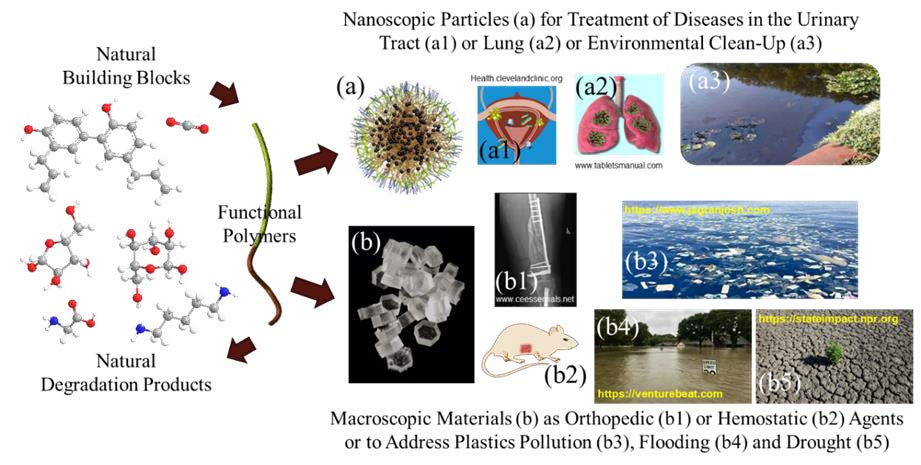Abstract
SYNTHETIC STRATEGIES BY WHICH TO AFFORD
NATURAL PRODUCT-BASED POLYMER MATERIALS:
IMPACTS ON SUSTAINABILITY, LIFE, HEALTH AND THE ENVIRONMENT
A primary interest in the Wooley laboratory is the production of functional polymers from renewable sources that are capable of reverting to those natural products once their purpose has been served. A long-standing focus has been the development of synthetic methodologies that transform sugars, amino acids and other natural products into polymer materials. This approach allows for the production of functional polymers from renewable sources that are capable of reverting to those natural products once their purpose has been served (as is illustrated on the left side of the diagram below). This holistic life cycle approach is of importance from the perspectives of sustainable sourcing of materials feedstocks, while creating mechanisms for breakdown of the polymer materials after useful lifetime is complete, and providing for biological and environmental resorption of breakdown products. The overall process impacts the need to address the increasing accumulation and associated hazards of plastic pollution from the environmental persistence of non-degradable, petrochemically-sourced polymer systems. Moreover, inherent diversities of natural products provide opportunities to expand the scopes, complexities and properties of polymers, by utilizing fundamental organic chemistry approaches.
Target materials are designed for potential applications in diverse areas. For instance, we have produced amphiphilic block polymers that undergo supramolecular assembly in water to afford well-defined nanoscopic particles (diagram below, upper section (a)). By tuning the composition, structure and morphology, we are able to build functional nanoparticles that demonstrate efficacy as therapeutic nanomedicines for treatment of recurrent urinary tract infections (a1) and lung infections (a2), and we're working toward their use in the treatment of osteosarcoma lung metastases. When the amphiphilic block polymers are co-assembled with iron oxide nanoparticles, magnetically-responsive organic-inorganic composite nanosystems result, which are able to perform as environmental remediation agents that capture ten times their mass in crude oil from contaminated water (work that began following the Deep Water Horizon oil spill a decade ago). Macroscopic forms (diagram, lower section (b)) of our Sugar PlasticsTM were initially studied with an aim toward their use in orthopedic applications (b1), when we identified that specific chemical compositions containing nanoscopic and microscopic porosities operate as bioresorbable hemostatic wound dressing materials (b2). We're currently working with Teysha Technologies, LTD to advance these polymer materials for commercial translation as naturally-degradable plastic packaging to address the growing plastics pollution crisis (b3).

Most recently, in response to increasing challenges with climate change, we've designed analogs to exhibit properties that allow them to serve as superabsorbent degradable polymers to capture excessive liquid water, thereby preventing flooding, and later degrade to release the natural building blocks and water, thereby mediating drought and promoting crop growth (work that began from struggling through Hurricane Harvey in 2017).
This presentation will highlight synthetic strategies for the development of polymers, block polymers and crosslinked network materials, which can be produced by relatively simple approaches from glucose and can be made to exhibit a range of properties. Target materials are designed for potential applications in diverse areas, from medicine, e.g., as nanotherapeutics or bioresorbable hemostatic agents, to the environment, e.g., as pollutant capture agents, climate resilient hydrogel materials or naturally-degradable plastics. Examples will highlight contributions that polymer chemistry can make toward bulk technological materials that are capable of impacting global needs, such as water-food-energy-health, and the grand challenges that must be solved in the coming decade.
Dr. Karen L. Wooley
Texas A&M University,
Departments of Chemistry, Chemical Engineering, and Materials Science & Engineering
College Station, Texas, USA
wooley(ELIMINAR)@tamu.edu

